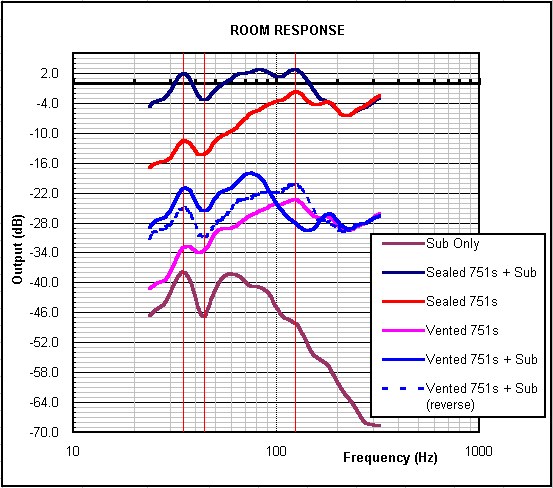
The Subwoofer Page v1.1
Subwoofer + Satellite Response Curves
Author: Brian Steele
Last Updated: 09 August 2015
The graphs below show the frequency response curves of my present INF10 subwoofer system plus the response of my Mission 751 main speakers, in my present living room.

The mauve graph is the response of the subwoofer alone. The subwoofer output from the my Technics receiver is rolled off above 100 Hz at 12dB/oct, and this is reflected in the measured response curve. The 6dB dip at 44Hz is a room artifact.
The red graph is the response of the Missions with their ports stuffed with damping material, which basically converts them into sealed systems. Now, why would I do this? Well, examine the dark blue graph, which is the combined response of the subwoofer and the Mission 751 speakers in sealed configuration. The response of the subwoofer is set about 4-5dB higher than the main speakers, to match my personal preferences. Bring it down by 4dB, and the response will be basically flat (except for that 6dB dip) from below 30 Hz to 200 Hz. Not too bad at all.
Now let's look at what happens if we leave the Mission 751 speakers in their normal vented configuration and then add the subwoofer. The solid blue line shows the combined response of the vented 751 speakers with the subwoofer - notice the DIP in response between 100 to about 180 Hz, then the massive peak at 75 Hz? Not very nice! This dip and peak could probably be adjusted by turning down the subwoofer's output a little, but at the expense of the low bass response.
Now, let's see what happens if we reverse the leads to the sub (basically changing the phase by 180 degrees). The resulting response is indicated by the dashed blue line on the graph. No dip and peak in the x-over region this time, but notice the downward sloping response from 120 Hz? This ain't too hot either!
So, it seems from the measurements that the combination of the sealed Mission 751s and the subwoofer provides the best response. This combination comes with problems of its own though - the power handling of the main speakers is now reduced within their passband, and there's still a little too much interaction between the subwoofer and the main speakers. However, the combined response of this system is definitely better than any of the vented combinations.
Future Improvements
I think that the overall response of this system can be improved as follows:
The Room
Pictured below is the room in which the above response measurements were taken.
My normal listening position is right where the SPL meter is located (yes,
sometimes I like listening to my music lying down :-)). The INF10 subwoofer is located right behind the right Mission
751 main speaker in the picture. It used to be located where my the computer, er,
measuring system is, but the new location seems to provide a much smoother response.

Brian Steele
www.diysubwoofers.org